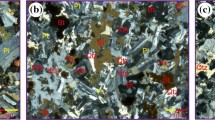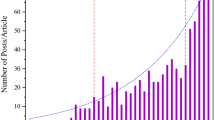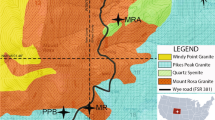Abstract
Motivated by the potential field application of microwave-assisted rock breakage in rock engineering, microwave irradiation tests with open-ended applicators (hereafter surface irradiation) have been comprehensively carried out. In the present study, three kinds of igneous rocks were selected to conduct tests under different microwave conditions. The heating characteristics and cracking behaviors of the rocks under surface irradiation were obtained and the influences of rock and microwave conditions were analyzed. Furthermore, numerical simulations were conducted using COMSOL Multiphysics to obtain the temperature and stress distribution inside the rock. The results show that the highest surface temperature and the number, total length and maximum width of the cracks of igneous rocks increase with the microwave power level and duration. Under the same microwave condition, the diabase has the best heating characteristics and cracking behaviors, followed by quartz monzonite, and then alkali-feldspar granite. Dense crack zones within the irradiation area and radial cracks extending to the sample edges can be observed under surface irradiation. The dense crack zone is formed due to the differential expansion between minerals, while the generation of radial cracks is related to the circumferential tensile stress caused by the thermal expansion of the rock center.
Highlights
-
Conducted surface irradiation on three kinds of igneous rocks.
-
Analyzed the influence of rock and microwave conditions on cracking effect.
-
Simulated the temperature and stress distribution inside the irradiated rocks.
-
Revealed the cracking mechanism of rock under surface irradiation.



















Similar content being viewed by others
References
Ali AY, Bradshaw SM (2009) Quantifying damage around grain boundaries in microwave treated ores. Chem Eng Process Process Intensif 48:1566–1573
Feng XT, Zhang JY, Yang CX et al (2021) A novel true triaxial test system for microwave-induced fracturing of hard rocks. J Rock Mech Geotech Eng 13:961–971. https://doi.org/10.1016/j.jrmge.2021.03.008
Ghiorso MS, Carmichael ISE, Moret LK (1979) Inverted high-temperature quartz. Contrib Mineral Petrol 68:307–323
Hager I (2014) Sandstone colour change due to the high temperature exposure. Adv Mater Res 875–877:411–415
Hartlieb P, Grafe B (2017) Experimental study on microwave assisted hard rock cutting of granite. BHM Berg-Hüttenmännische Mon 162:77–81
Hartlieb P, Toifl M, Kuchar F et al (2016) Thermo-physical properties of selected hard rocks and their relation to microwave-assisted comminution. Miner Eng 91:34–41
Hartlieb P, Grafe B, Shepel T et al (2017) Experimental study on artificially induced crack patterns and their consequences on mechanical excavation processes. Int J Rock Mech Min Sci 100:160–169
Hassani F, Nekoovaght PM, Gharib N (2016) The influence of microwave irradiation on rocks for microwave-assisted underground excavation. J Rock Mech Geotech Eng 8:1–15
Kingman SW, Jackson K, Cumbane A et al (2004) Recent developments in microwave-assisted comminution. Int J Miner Process 74:71–83
Koiwa T, Shiratori Y, Takahashi H et al (1975) Rock breaking by microwave radiation-effects of local heating and thermal fracture. Ministry of Transport, pp 181–209
Lu GM, Feng XT, Li YH et al (2019) The microwave-induced fracturing of hard rock. Rock Mech Rock Eng 52:3017–3032
Ma ZJ, Zheng YL, Li XZ et al (2021) Design and performance of an open-ended converging microwave antenna in fracturing biotite diorite at low microwave power levels. Geomech Geophys Geo-Energ Geo-Resour 7:95. https://doi.org/10.1007/s40948-021-00291-0
Meisels R, Toifl M, Hartlieb P et al (2015) Microwave propagation and absorption and its thermo-mechanical consequences in heterogeneous rocks. Int J Miner Process 135:40–51. https://doi.org/10.1016/j.minpro.2015.01.003
Meredith RJ (1997) Engineers’ handbook of industrial microwave heating [Book Review]. Power Eng J 13:3–4
Qin LK, Dai J (2016) Analysis on the growth of different shapes of mineral microcracks in microwave field. Fratt Ed Integr Strut 37:342–351
Rizmanoski V (2011) The effect of microwave pretreatment on impact breakage of copper ore. Miner Eng 24:1609–1618
Salsman JB, Williamson RL, Tolley WK et al (1996) Short-pulse microwave treatment of disseminated sulfide ores. Miner Eng 9:43–54
Santamarina JC (1989) Rock excavation with microwaves: a literature review. Found Eng Curr Princ Pract 1:459–473
Satish H, Ouellet J, Raghavan V et al (2006) Investigating microwave assisted rock breakage for possible space mining applications. Min Technol 115:34–40
Scott G, Bradshaw SM, Eksteen JJ (2008) The effect of microwave pretreatment on the liberation of a copper carbonatite ore after milling. Int J Miner Process 85:121–128
Shepel T, Grafe B, Hartlieb P et al (2018) Evaluation of cutting forces in granite treated with microwaves on the basis of multiple linear regression analysis. Int J Min Miner Eng 107:69–74
Toifl M, Hartlieb P, Meisels R et al (2017) Numerical study of the influence of irradiation parameters on the microwave-induced stresses in granite. Miner Eng 103–104:78–92
Vazquez P, Acuna M, Benavente D et al (2016) Evolution of surface properties of ornamental granitoids exposed to high temperatures. Constr Build Mater 104:263–275
Von Hippel AR (1954) Dielectric materials and applications. Wiley, New York
Vosteen HD, Schellschmidt R (2003) Influence of temperature on thermal conductivity, thermal capacity and thermal diffusivity for different types of rock. Phys Chem Earth Parts a/b/c 28(9–11):499–509
Wang YC, Djordjevic N (2014) Thermal stress FEM analysis of rock with microwave energy. Int J Miner Process 130:74–81
Waples DW, Waples JS (2004) A review and evaluation of specific heat capacities of rocks, minerals, and subsurface fluids. Part 1: Minerals and nonporous rocks. Nat Resour Res 13:97–122
Whittles DN, Kingman SW, Reddish DJ (2003) Application of numerical modelling for prediction of the influence of power density on microwave-assisted breakage. Int J Miner Process 68:71–91
Xiao JK (1990) Dielectric properties of minerals and their applications in microwave remote sensing. Chin J Geochem 9:169–177
Xu T, Yuan Y, Heap MJ et al (2021) Microwave-assisted damage and fracturing of hard rocks and its implications for effective mineral resources recovery. Miner Eng 160:106663
Zhao XB, Yao XH, Gong QM et al (2015) Comparison study on rock crack pattern under a single normal and inclined disc cutter by linear cutting experiments. Tunn Undergr Space Technol 50:479–489
Zhao QH, Zhao XB, Zheng YL et al (2020a) Heating characteristics of igneous rock-forming minerals under microwave irradiation. Int J Rock Mech Min Sci 135:104519
Zhao QH, Zhao XB, Zheng YL et al (2020b) Microwave fracturing of water-bearing sandstones: Heating characteristics and bursting. Int J Rock Mech Min Sci 136:104495
Zheng YL, Sun TW (2021) A method to derive the dielectric loss factor of minerals from microwave heating rate tests. Measurement 171:108788
Liu HW (2018) Study on temperature rising and weakening effect of minerals and rocks under microwave irradiation. Dissertation, Nanjing University (in Chinese)
Nejati H, Hassani F, Radziszewski P (2012) Experimental investigating of fracture toughness reduction and fracture development in basalt specimens under microwave illumination. In: Proceeding of Earth and Space Conference, California, pp 325–334. https://doi.org/10.1061/9780784412190.036
Acknowledgements
This study was funded by the National Natural Science Foundation of China (Grant No. 41372266) and the Entrepreneurial Team Program of Jiangsu Province, China (JSSCTD202140).
Author information
Authors and Affiliations
Corresponding author
Ethics declarations
Conflict of interest
The authors declare that they have no known competing financial interests or personal relationships that could have appeared to influence the work reported in this paper.
Additional information
Publisher's Note
Springer Nature remains neutral with regard to jurisdictional claims in published maps and institutional affiliations.
Rights and permissions
About this article
Cite this article
Zhao, X.B., Zhao, Q.H., Zheng, Y.L. et al. Cracking Behavior and Mechanism of Igneous Rocks Under Open-Ended Microwave Irradiation. Rock Mech Rock Eng 55, 6151–6169 (2022). https://doi.org/10.1007/s00603-022-02978-6
Received:
Accepted:
Published:
Issue Date:
DOI: https://doi.org/10.1007/s00603-022-02978-6




